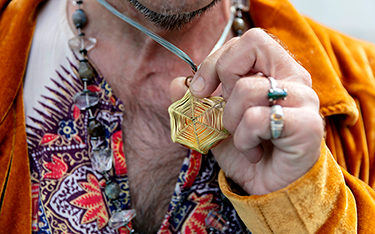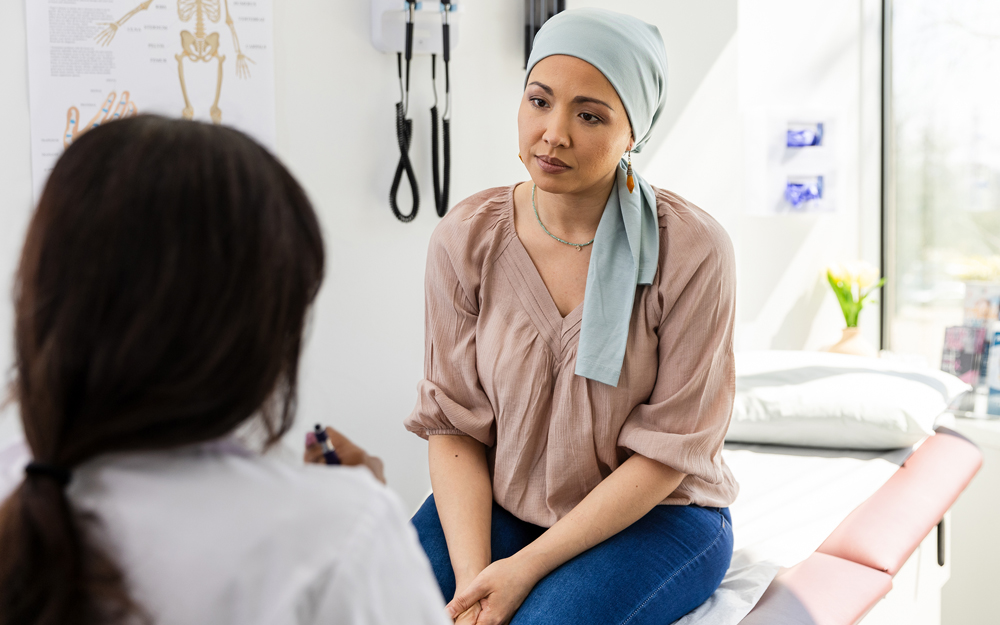Moving Forward From Precancer
Date
November 6, 2023

Date
November 6, 2023
Credits
Medical providers featured in this article
In Brief
{{cta-block}}
Sean Owen’s eyes sparkle when he thinks about the stage. He’s been acting, playing piano, tap dancing and belting out Les Miserables’ “One Day More” since he was 12.
When he’s not performing, you might still spot the artist in a crowd, donning a vintage sailor cap and the bright crystal jewelry he makes by hand. Sometimes he paints—a family tradition—or knits, branching out to new forms of expression through the years.
He’s likely, though, to be paying attention to others.
“People inspire me,” he said. “Seeing someone act kindly moves me to express kindness and positivity in my art.”
When it’s time to visit his doctor, Sean packs up his gemstones and crafting materials and boards an Amtrak train from his Grover Beach home to Cedars-Sinai. He watches out the window as the Central Coast gives way to urban Los Angeles, and he begins to create.
Worth the Journey

Sean’s appointments with Jason Kauffman, DO, a family medicine physician in Cedars-Sinai’s LGBTQ+ Center, are a welcome adventure—like seeing an old friend he would never cancel on.
In 2017, the recent California transplant suddenly felt severe lower pelvic pain. He struggled to find a specialist he connected with. One refused to examine him.
“You can tell when a doctor doesn’t care,” he said. “You feel violated and have unanswered questions.”
Other providers judge LGBTQIA+ patients, making them think they need to hide their identity, he added.
Eventually, a community health center referred Sean to Kauffman, who was at UCSF Medical Center in San Francisco at the time. Kauffman determined his new patient’s pain was coming from an internal fissure—a tear in the anal tissue.
Sean was “terrified and embarrassed” going into such a vulnerable appointment, but the pair immediately connected. Kauffman, who also identifies as gay, treated him with dignity and respect. And the doctor’s warm, down-to-earth personality removed any lingering shame Sean was feeling.
“It would be hard to trust anyone else like I trust him,” said Sean, who followed Kauffman when the specialist moved to Cedars-Sinai five years later.
A Life-Saving Screening
Kauffman is an expert in anal dysplasia—tiny cellular changes linked to the human papillomavirus (HPV) that can evolve into cancer. He physically examines patients for solid lumps or bumps that might signal anal cancer and also swabs the anal canal.
He also uses high-resolution anoscopy—an advanced technique—for diagnosis. The exam uses a small, hollowed-out plastic tube called an anoscope. Iodine solution and vinegar highlight risky areas—sticking to and dyeing precancerous cells and feeding connected blood vessels—while Kauffman magnifies them with a diagnostic device.
When an anoscopy shows unusual areas, he takes a biopsy around the size of a sesame seed. If the patient has precancer, Kauffman numbs and burns off the tissue, just as a dermatologist would treat a skin lesion.
Medical care came just in time for Sean, who had no symptoms aside from the unrelated fissure pain. But at his first appointment, Kauffman discovered abnormal cells and took action.
“It’s sneaky,” Sean said. “I could easily have developed cancer without knowing until it was too late.”
Get Tested

Anal dysplasia hides out inside many hard-to-see folds in the anal canal, according to Kauffman. Typically silent or causing mild symptoms such as bleeding, these clusters of cells are often overlooked or confused for hemorrhoids.
Unlike with other routine health checks, many patients skip anal dysplasia screenings due to stigma and fear.
“People are generally uncomfortable with anal health,” said Kauffman.
He reassures patients that anoscopy is not painful. It just causes a sensation of mild pressure, and the exam is complete in 10 to 15 minutes. Numbing cream and a sedative ease the process.
The screening is different than a colonoscopy, which can trip up people, too. Anoscopy and colonoscopy each catch different conditions, with anoscopy zoomed in to see anal cells.
An estimated 79,100 people are living with anal cancer, according to the National Cancer Institute, and new cases and deaths are growing—with around 9,760 diagnoses in 2023. Gay and bisexual men are 20 times more likely to get the cancer, the National LGBT Cancer Network notes, and risk doubles for those who are HIV-positive.
HPV, another main risk factor for anal cancer, eventually affects nearly all sexually active people. For certain communities, though, the virus is more dangerous and can lead to anal dysplasia and, subsequently, cancer.
Men who have sex with men and people who have suppressed immune systems should begin annual anoscopies at 35, especially if they smoke. People who have HIV should start younger, at age 25, Kauffman recommends, since HIV and HPV work together to compromise tissue.
Women with past cervical or vulvar precancers, cancers, or perianal warts should also consider annual Pap smears.
Unfortunately, few people know their risk.
“I went into this field because I wanted to take care of my community,” Kauffman said, adding that specialists are rare.
His approach is effective, according to evidence mounting with the groundbreaking 2022 ANCHOR Study, which Kauffman collaborated on.
“It’s way better to catch dysplasia before it turns into cancer,” he said, sparing patients intensive chemotherapy and radiation, side effects, and even death.
Early diagnosis can also safeguard your sex life.
“Most people can’t have receptive anal sex again after anal cancer, but they can with dysplasia treatment,” Kauffman said.
He strongly recommends seeking a doctor who is well-trained in high-resolution anoscopy, noting that the recent successful findings led to underqualified people offering lower-quality procedures. One benchmark is whether the doctor has received anoscopy education through the International Anal Neoplasia Society, with at least a few years of experience.
Patients should also find out if the provider uses the correct tools (microscope, vinegar and Lugol’s solution) to check for any lesions, as well as if they unnecessarily send patients to the operating room under anesthesia rather than quickly doing the procedure in the doctor’s office.

Repeat Growth
In the years since Sean’s diagnosis, Kauffman has treated around five lesions for him.
Lesions frequently return, and the cells grow quickly—even in the few months between appointments. The artist faithfully visits his doctor every three to six months and will likely need to maintain that schedule for the rest of his life to keep cancer at bay.
Face your fear, Sean encourages others, and don’t get complacent with follow-up appointments.
“It truly is a matter of life and death,” he stressed.
Sean’s Next Act
Life keeps throwing curveballs at the 51-year-old. He’s now healthy, but his brother, Bill—the other “Owen boy” and artist—died unexpectedly in June 2023.
It’s easy to focus on the negatives amid repeated health scares and grief.
But Sean, who is spiritual, has faith that this life isn’t the final destination. So, while he’s at this stop on his journey, he’s decided to stay open—to care, laughter, lessons, creation—and to his two rescue cats, who showed up and never left. He’s ready for whatever comes around the bend.
His favorite healing crystal, an opal, symbolizes hope.
On the shores of the Pacific Ocean, water laps at Sean’s bare feet, grounding him and reminding him to look around.
“You have to peel the layers back to find the beauty,” he said.
LGBTQIA+ Community Care
Finding a doctor who values you and understands your needs is vital.
However, many lesbian, gay, bisexual and queer people can’t—no matter how hard they try. The LGBTQIA+ community faces more medical discrimination and feels less respected (37%, according to a Healthgrades survey) and heard by doctors. In turn, many avoid or postpone care: About half of LGBTQIA+ people delayed appointments in the previous year, according to the same survey, and had double the rate of avoidance due to a bad experience compared to their non-LGBTQIA+ peers.
“Patients often don’t trust they will be accepted for who they are, so they have a hard time sharing important and relevant health information,” said Alen Voskanian, MD, chief operating officer of the Cedars-Sinai Medical Network.
The new LGBTQ+ Center at Cedars-Sinai is working to counteract inequalities with inclusive care that encompasses:
- Adult primary care, focusing on gender wellness and hormone replacement therapy
- Gender-affirming surgery
- High-resolution anoscopy and anal dysplasia diagnosis and treatment
“We wanted to pay attention to the entire care experience, asking open-minded questions and making everyone feel welcome from the first call,” Voskanian stressed.





